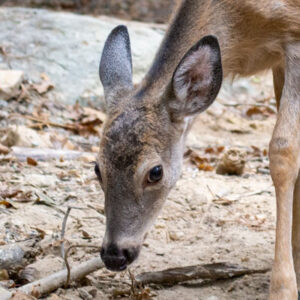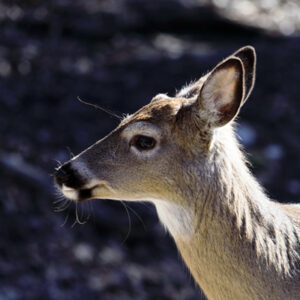
WHITE-TAILED DEER
You would not think so based on their hoofed feet, but white-tailed deer are great swimmers and often use streams and lakes to escape predators.
PROFILE
Both of our white-tailed deer were deemed non-releasable by their rehabber. Her experience has found that deer undergoing rehabilitation have a higher success rate when raised in pairs.
Fenway was deemed non-releasable because he was too friendly towards humans. He will come right up to the fence whenever there are people around to see if they have any food. His favorite snack is grapes but he will be satisfied with scratches on the head.
You may notice that Wrigley’s back legs look different and are carried in an odd way. This was caused by a car accident. Our veterinarian determined the best course of action would be to remove the damaged hip bone. The YRWS keepers helped Wrigley with physical therapy to build the muscle in his legs to improve his mobility. Along with daily walks, Wrigley enjoyed aqua therapy in the bear pond – before the bears moved in, of course! Wrigley is now fully recovered and doing well… his antlers have even begun to grow in!

WRIGLEY

FENWAY
OVERVIEW
CONSERVATION STATUS
Least Concern
AVERAGE SIZE
Compared to a 6′ Man
AVERAGE WEIGHT
110 – 300 lbs
AVERAGE LIFESPAN
2 – 3 Years
DIET
Omnivore
REGIONS
North & Central America
White-tailed deer can be found from Canada through Central America as far as Bolivia. They prefer open woodland but, as we know, will also live in urban and farming regions. They are typically found near streams and rivers.
APPEARANCE
While they are the smallest deer in North America, they are still somewhat large reaching four feet at the shoulder and as much as 300 pounds. Adults have reddish-brown fur during the summer which fades to gray tones to blend in with winter camouflage. Fawns are born with spotted coats to help them blend into the forest floor. They are ungulates, meaning they have hoofed feet. Males can be distinguished by their antlers which fall off every winter. The undersides of their tails are white and displayed when they sense danger, maybe as a warning for others nearby.
CHARACTERISTICS
White-tailed deer are very shy and tend to be solitary animals. Does are protective of their fawns and take great care to hide them while they search for food. They typically graze before dawn, rest during the afternoon then return to grazing in the late afternoon. Depending on the area, they like to eat the buds and twigs of maple, sassafras, poplar, aspen and birch along with a variety of shrubs.
White-tailed deer are agile and fast, reaching speeds up to 30 miles per hour, jumping ten feet high and as far as 30 feet in length! If they are being chased by a predator, they will head towards a stream or lake and swim to safety.
During the rut (mating season) the bucks will use their large antlers to fight over territory and choose a doe. In early spring, does give birth to one to three fawns after a gestation period of about seven months.


